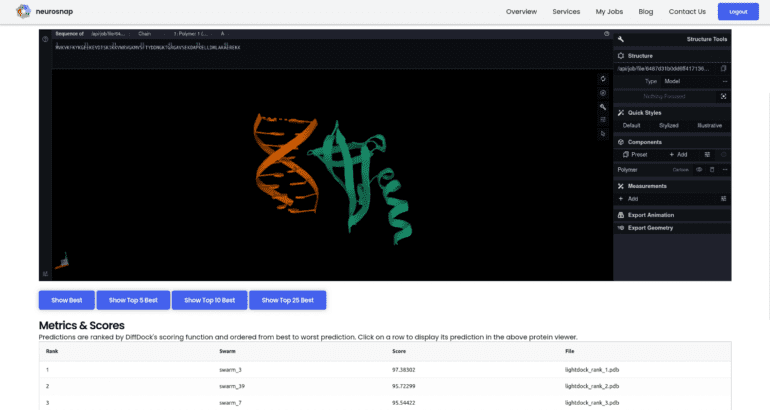TL;DR:
- Neurosnap, a startup, pioneers accessible machine learning tools for biology research.
- The platform bridges the gap between complex bioinformatic tools and researchers with no coding expertise.
- CEO Keaun Amani emphasizes democratizing access to advanced bioinformatic resources.
- Neurosnap’s user-friendly interface empowers biologists to focus on research questions, not technicalities.
- Researchers can analyze intricate biological phenomena and predict protein structures efficiently.
- The platform’s impact on pharmaceutical and medical fields includes faster drug discovery and pathway analysis.
- Neurosnap unites researchers from diverse backgrounds, promising limitless advancements in biology.
Main AI News:
In the dynamic realm of computational biology, Neurosnap, a pioneering startup, is redefining the landscape through its groundbreaking integration of machine learning. This visionary venture is ushering in a new era of accessibility to cutting-edge bioinformatic tools and models, eliminating the technical barriers that have hindered scientific progress in fields such as synthetic biology, pharmaceuticals, and medical research.
The fusion of machine learning and biology has sparked immense excitement in recent years, exemplified by innovations like AlphaFold2, which promise to unlock unprecedented possibilities for biologists. Yet, the complexity of seamlessly incorporating these advanced tools into existing research pipelines has posed a substantial challenge for many. Neurosnap, with its comprehensive suite of user-friendly machine learning resources, endeavors to shatter this obstacle and pave the way for transformative discoveries.
Keaun Amani, the CEO and co-founder of Neurosnap, articulates the company’s mission succinctly: “Neurosnap envisions a future where computational biology reshapes our understanding of intricate biological processes. Our mission is to democratize access to advanced bioinformatic tools, empowering researchers from diverse backgrounds to harness the potential of machine learning without the encumbrance of technical intricacies.“
Neurosnap distinguishes itself with its intuitive interface, catering to researchers with limited or no prior machine learning experience. By negating the necessity for coding expertise, the platform liberates biologists to focus on their fundamental research inquiries, sparing them the complexities of data analysis.
Researchers wielding Neurosnap can delve into the intricacies of biological phenomena, scrutinize complex genomic datasets, and forecast protein structures with unprecedented ease. The platform leverages the latest in machine learning algorithms, empowering biologists to unravel the enigmas of life with unprecedented efficiency.
The implications of Neurosnap in the pharmaceutical and medical sectors are particularly auspicious. By facilitating the identification of potential drug candidates, prognosticating protein interactions, and dissecting disease-related pathways at an accelerated pace, the platform promises to expedite drug discovery and development timelines significantly.
Conclusion:
Neurosnap’s integration of machine learning into biology research streamlines access to advanced bioinformatic tools. This innovation has the potential to significantly impact the market by expediting scientific discoveries in pharmaceuticals, medical research, and synthetic biology. Researchers from various fields can now harness the power of machine learning, paving the way for transformative advancements in computational biology.

